4 Spring Wild Edibles You Don’t Want to Miss
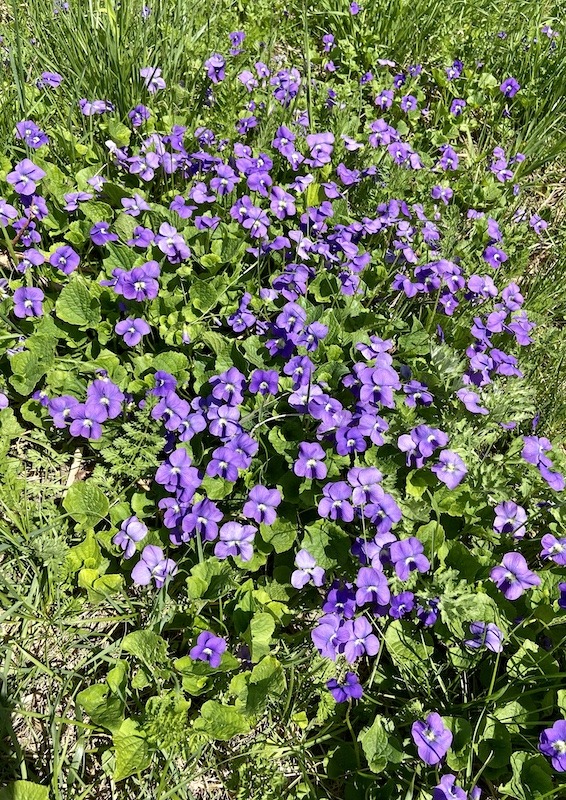
Posts may contain links to products and services I love. I may make a small commission from them, at no extra cost to you. Thank you for supporting my blog.
Spring is a fabulous time to forage for wild edibles. All the new plant growth means lots of wild greens for salads and cooked vegetables. As the spring unfolds, different wild edibles come into their prime and then fade quickly away. It’s all about timing to harvest each wild edible at their delicious best. Foraging for this free food that some consider weeds is a cherished spring pastime.
In previous posts I have covered ramps or wild garlic and fiddleheads in depth. In this post, I share four of my additional favorite spring wild edibles. You will find information about how to identify each one, where to forage for them, and one of my favorite ways to prepare them.
Collecting and eating wild foods requires attention to ethics and safety. Use these do’s and don’t’s of foraging as a guide.
I’ve done numerous hikes in New England where I suddenly discover a patch of wild edibles. In the spring I usually carry my wild edible daypack. My foraging daypack contains reusable plastic bags, kitchen scissors, trowel, jackknife, a field guide to wild edibles, a water bottle for drinking water and washing plants, and a pack towel to wipe the dirt off my hands. My go-to field guide is the Peterson Field Guide to Edible Wild Plants.
Spring Wild Edibles: Nettle
Nettle is the superfood of the wild plant world. It’s chocked full of Vitamin A, C, and K, iron, calcium, and much more. Its anti-inflammatory properties make it a popular herbal remedy for such conditions as arthritis and seasonal allergies.
Nettle leaves have stinging hairs that cause a rash or itching when touched. Fortunately for wild food fans, the stinging hairs of nettle are denatured by heat. Therefore, cooking or drying nettle makes it harmless.
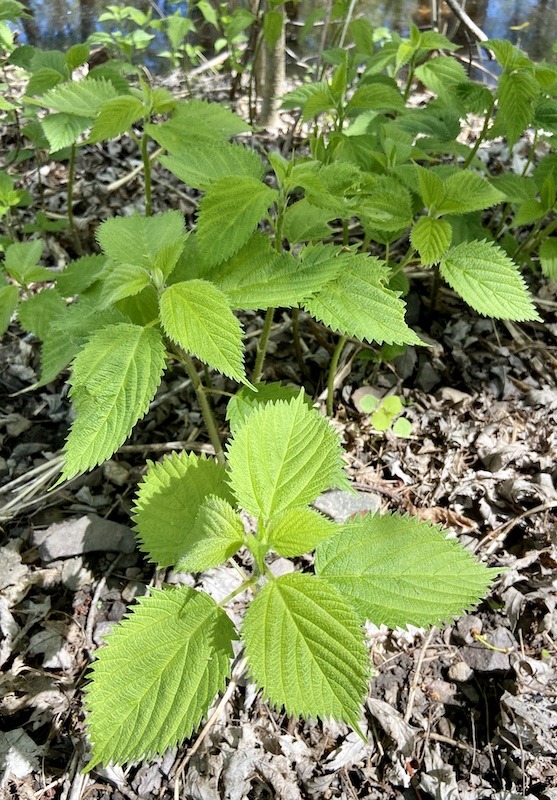
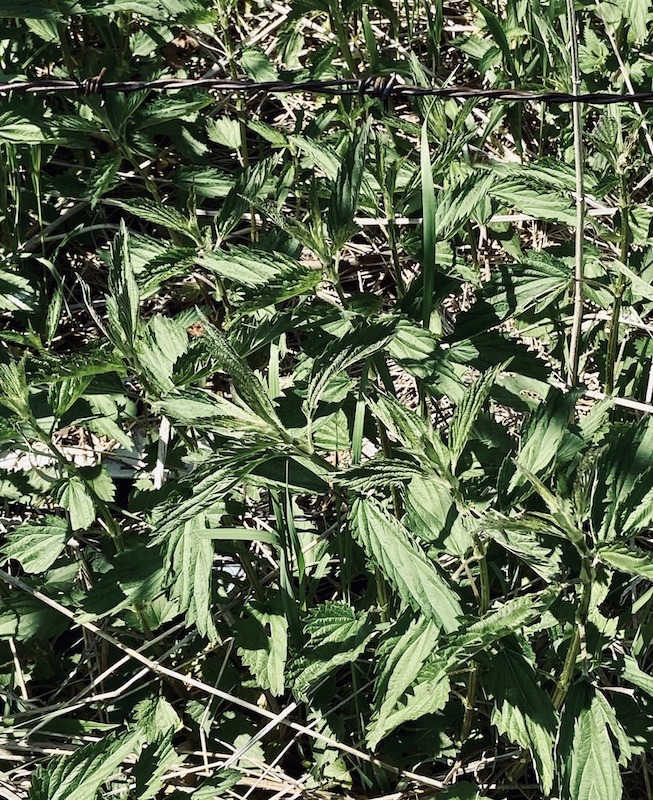
Foraging nettles
There are two kinds of nettles I use in my wild edible cooking. Stinging nettle is dark green and grows in disturbed soil areas. You can usually find stinging nettle in abandoned fields, ditches, and near streams and lakes.
Wood nettle is a lighter green with broader, more rounded leaves. It can be found in moist sunny hardwood forests and beside loamy streambeds.
Both kinds of nettles are prolific and invasive so they can be harvested heavily without harming the plant population. Gloves are recommended to prevent being stung but I use a plastic produce bag draped over my hand to pick when I don’t have gloves. I snap off the tender nettle tops and then turn the plastic bag inside out over the nettles to end up with a neat bag of green goodness.
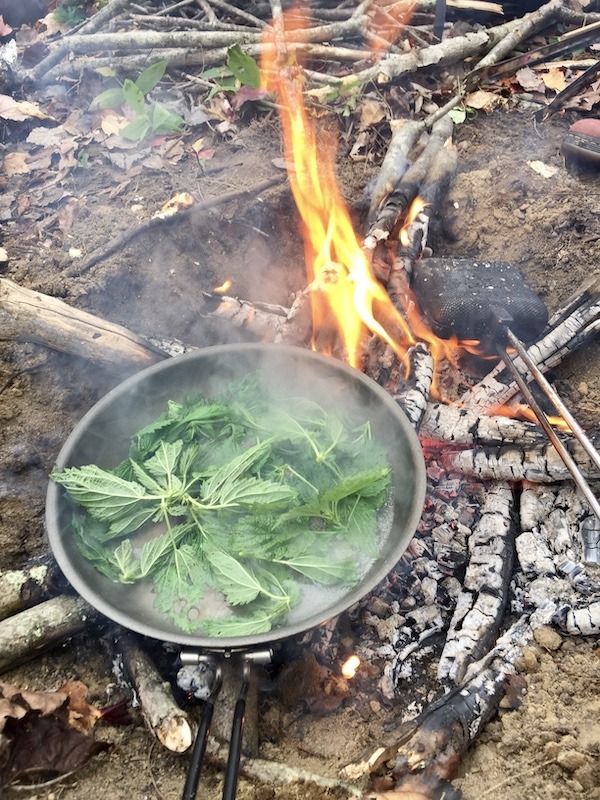
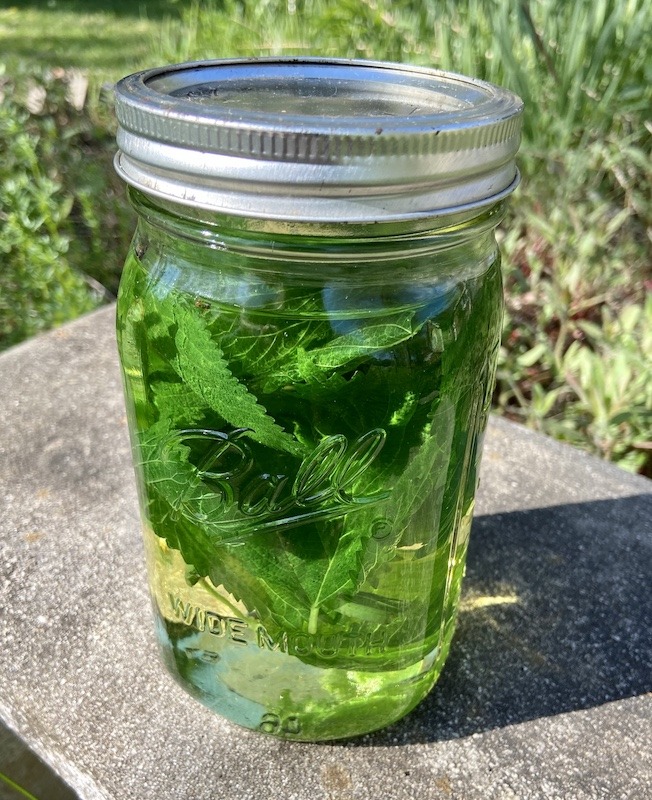
Cooking nettles when I’m camping is simple. Wash them and then saute in butter until tender. Squeeze a little lemon and a dash of salt and enjoy this spinach of the woods. They also make a wonderful sun tea rich in vitamins and anti-oxidants.
Nepali nettle soup
I was out recently collecting stinging nettles for my favorite nettle soup when I saw three women emerge from the woods with bursting bags of greens. Curious, I asked them what they had in the bags. They said nettles but made a point that they were not the stinging nettles I was collecting. They had harvested wood nettles which they insisted tasted better than stinging nettles. The women were from Nepal and told me about the wonderful Nepali nettle soup they made which was a tradition in their villages. I asked for the recipe. I searched where they told me to look and harvested a big bag of wood nettles to try out their Nepali soup recipe at home. Called Sishnu soup, the turmeric and garlic complement the taste of the nettles.
Ingredients:
- 2-4 cups nettles (washed)
- ½ cup white rice
- 4 cloves garlic- minced
- ½ tablespoon turmeric powder
- 1-2 teaspoons salt
- 1 tablespoon butter
- 4 cups or more water or vegetable stock
Boil nettles, rice, turmeric, and salt until the rice is cooked and the nettles are tender. Add more liquid if needed. Heat the butter and sauté the garlic. Add to the soup and adjust the seasonings. Ladle into bowls to serve.
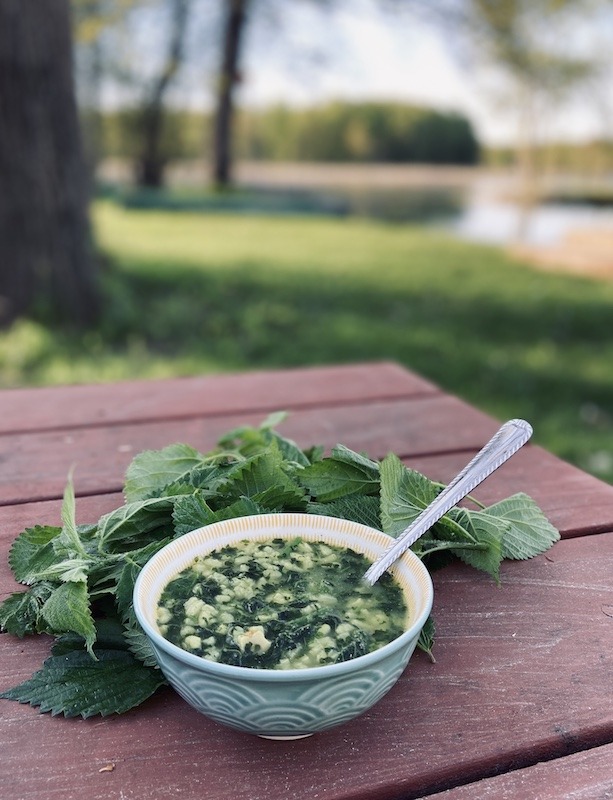
Spring Wild Edibles: Cattail
The cattail is a familiar plant to many who recognize the brown sausage-shaped heads growing in swamps or other wet areas. The long brown heads burst into cattail fluff in the fall to disperse their seeds.
While nettle is the superfood of the wild edible world, the cattail is the grocery superstore. So many parts of the cattail can be used depending on the season. In the summer, the young heads can be roasted or boiled and eaten like corn on the cob. Collect cattail pollen in mid to late summer for a protein-packed addition to pancake batter. The roots can be dried to make flour or eaten cooked when they are young. Dipped in oil or wax, the heads make a torch. I use the cattail fluff as a firestarter to catch a spark in my tinder bundle.
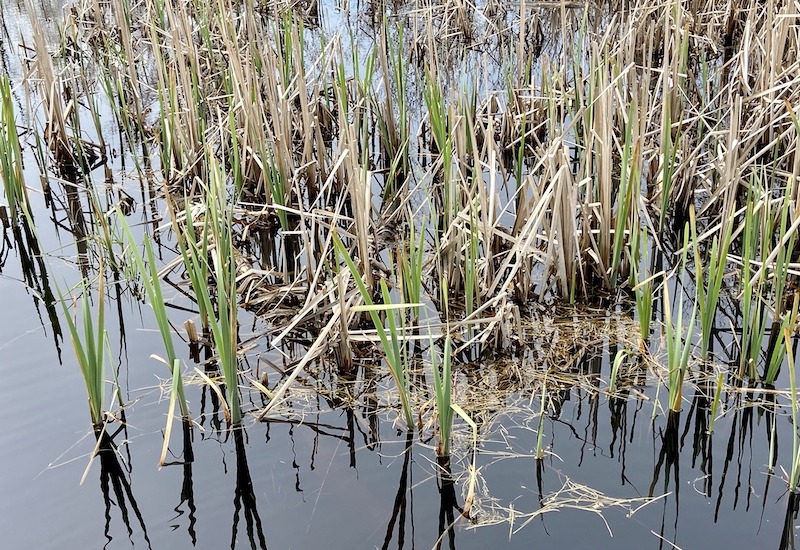
Foraging spring cattail
The star parts of the cattail as a spring wild edible are the bottom shoots. Don your muck boots and harvest them from the shallow cattail marsh. A trowel to dig under the water is handy to prevent breaking off the best part of the shoots. Alternately, you can use a knife to cut the shoots off right where they meet the roots. Harvest responsibly by only taking a few from each marsh. Additionally, make sure you are harvesting in a clean water source. Avoid swamps beside roads or near farm fields with pesticide run-off.
Peel off the outer leaves to reveal the white part of the stalk. You can snack on the white part after rinsing it. Or cut off about 6 inches directly below the green part to save for a dish. I think it tastes like a combination of cucumber and unsweetened watermelon.
Preparing cattail
Cattail shoots can be eaten as a cooked vegetable by stir-frying or steaming. However, my favorite way to eat them is with a simple marinade. The shoots prepared this way are reminiscent of hearts of palm but tastier in my opinion.
Cattail Marinade
- 1/4 cup olive oil
- 4 tablespoons soy sauce
- 1/4 cup lemon juice
- 1 clove garlic minced
Combine the ingredients in a small bowl. Cut the cattail shoots into 1 inch sections and add to marinade. Marinade 30 minutes. Enjoy as a side dish or on a salad.
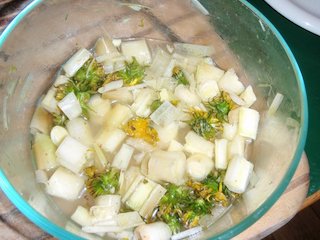
Spring Wild Edibles: Dandelion
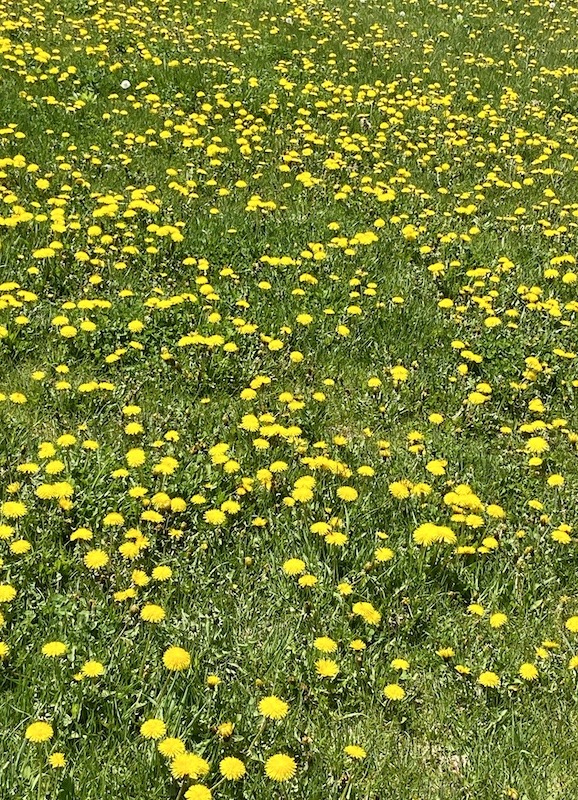
Dandelion is that ubiquitous yellow flower hated by lawn specialists and loved by kids of all ages. The leaves of the dandelion grace gourmet markets. If you like radicchio on steroids then dandelion greens might be for you. It takes getting used to their bitter taste but dandelions have tremendous medicinal and nutritional values.
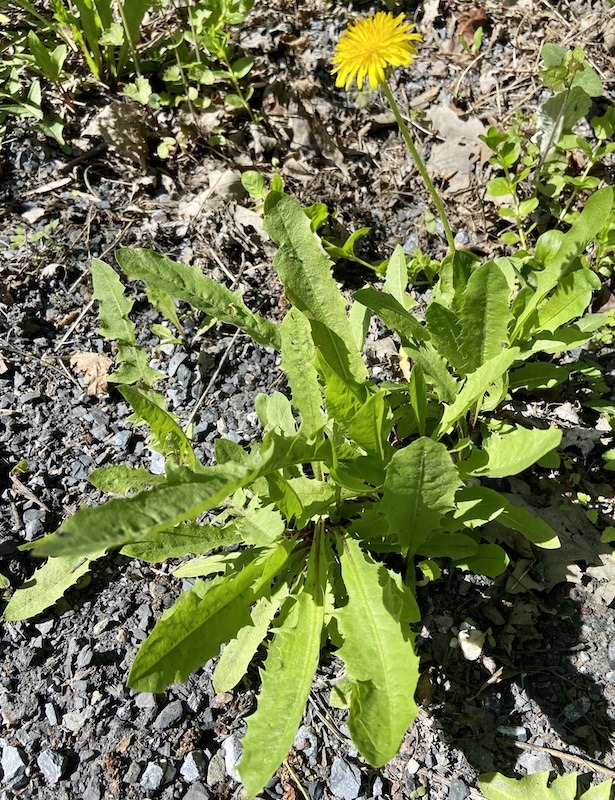
Harvest the greens when they are young before the flowers emerge. Boiling them in well-salted water will reduce the bitterness. You can also add strong flavors such as garlic, bacon, or chilis to temper the bitterness.
Another use of the dandelion is making a tea or coffee out of the dried and ground root. You can also garnish salads with the slightly sweet petals of the flower.
Dandelion head tempura
My favorite dandelion dish is to use the flower tops for a tempura-battered fritter. Harvest the mature flower heads. Wash and pat dry.
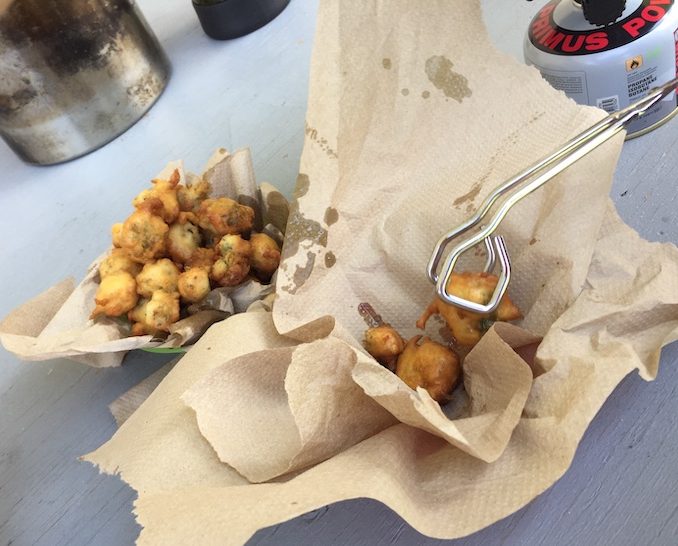
Ingredients:
- 1 cup all-purpose flour
- 1 cup ice water
- 1-2 large egg-beaten
The flour/ice water ratio is one to one. Add the ice water and beaten egg to the flour and mix with chopsticks for no more than a minute. Importantly, use the batter immediately while cold. Dip heads in tempura batter and fry in oil at 350 degrees. Drain on paper towels. Shake salt and pepper on them when they are hot so it sticks.
However, when I’m camping I use a prepared baking mix for the batter just to make it easier. Serve with a soy-ginger dipping sauce or with the ramp aioli described in my wild ramps post.
Spring Wild Edibles: Violets
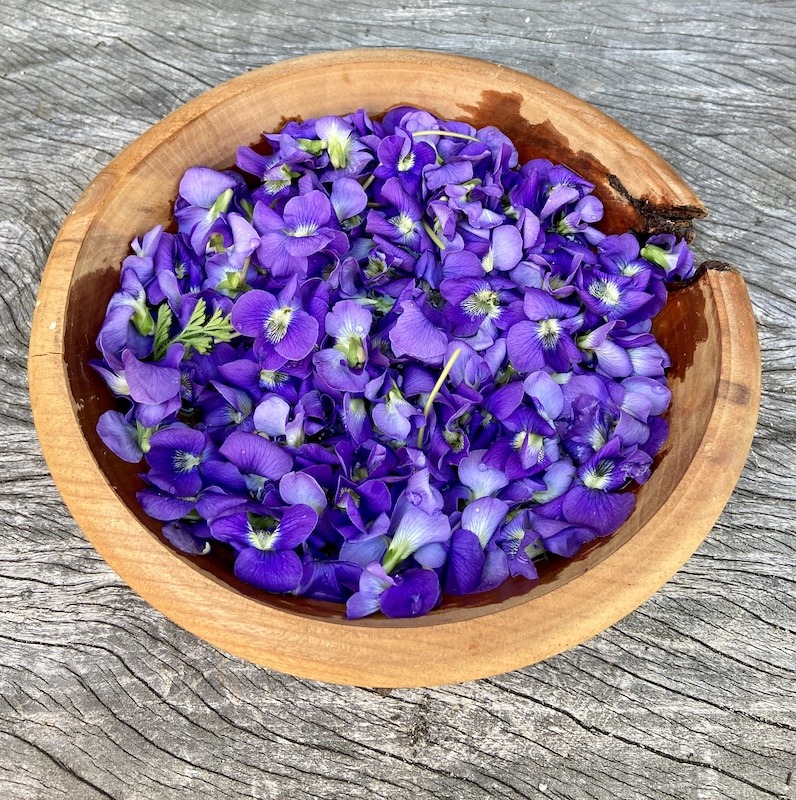
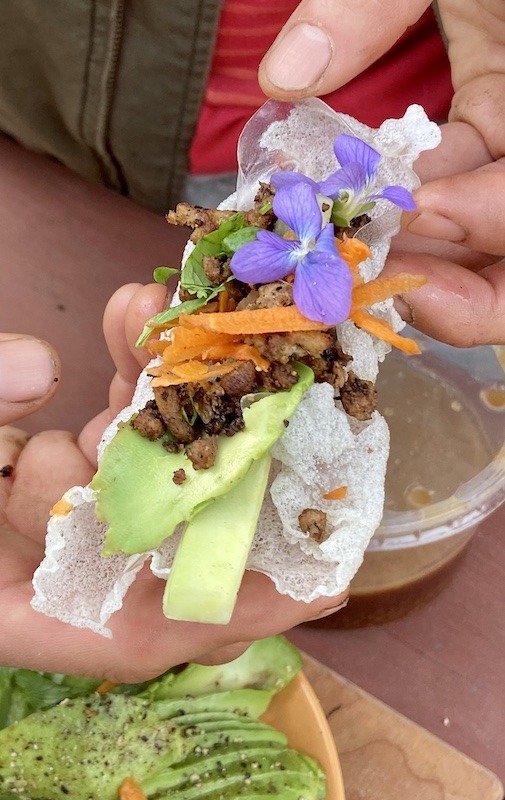
Violets are edible flowers that brighten any meal. The flowers are also a lovely snack to munch on when you find them along the trail. The oblong leaves are tasty in a wild greens salad. Furthermore, the flowers can be candied, used as a soup thickener, or added as a garnish to elevate any dish.
Violet flowers come in many colors. I pick purple, yellow, and white to use in my cooking and garnishes. They grow in fields or woods, thriving best in semi-shaded areas.
A family favorite way to use violet flowers is to make violet jelly. This purplish-pink preserve is delicious on biscuits and scones.
Violet jelly
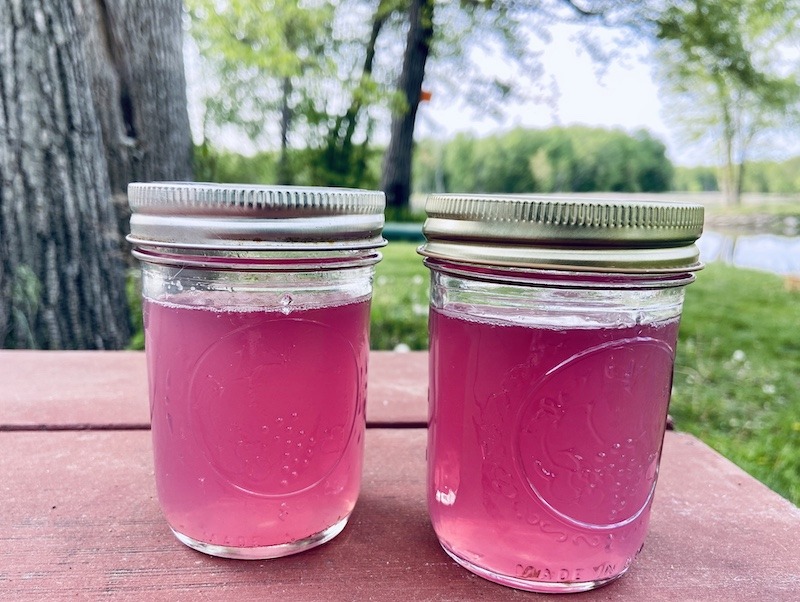
Ingredients:
- 3 cups violet flowers (petals only)
- 4 cups boiling water
- 1/4 cup lemon juice
- 2 cups of sugar
- Pectin (I swear by Pomona’s Pectin because you can reduce the sugar and still have it jell)
Pour the boiling water over the violet flowers in a glass jar. Cover and put the violet water aside until the flavor and color are extracted. Waiting 24 hours is ideal, but you can get away with a half a day. Stain the violet juice into a pot and discard the flowers. It will be an odd bluish color but the lemon will make it a nice pink color depending on how much you add.
Next, follow the pectin directions to make jelly. Bring the violet/lemon water to a full boil. Add the sugar/pectin mixture. Stir until dissolved and returned to a boil. Take off the heat and pour into sterilized jelly jars and seal.
Spring Wild Edibles Wrap-Up
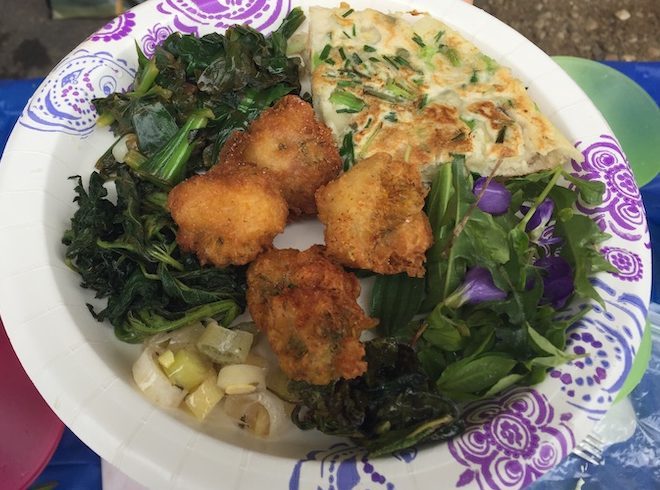
To sum it up, spring is an ideal time to use the outdoors as your farmer’s market. What many consider weeds can be turned into healthy and delicious dishes. The wild edibles featured here are found in the early spring. They grow tough or disappear as summer arrives. However, fear not! There are plenty of summer and fall wild edibles to enjoy.
I’ve shared four of my favorite spring wild edibles here. Check out my posts on fiddleheads and wild ramps for a couple more spring treasures. In addition, there are many more spring plants that are delicious, so grab your wild edible foraging pack and a good guidebook to find out what food is in your own backyard.
Pin it for later!
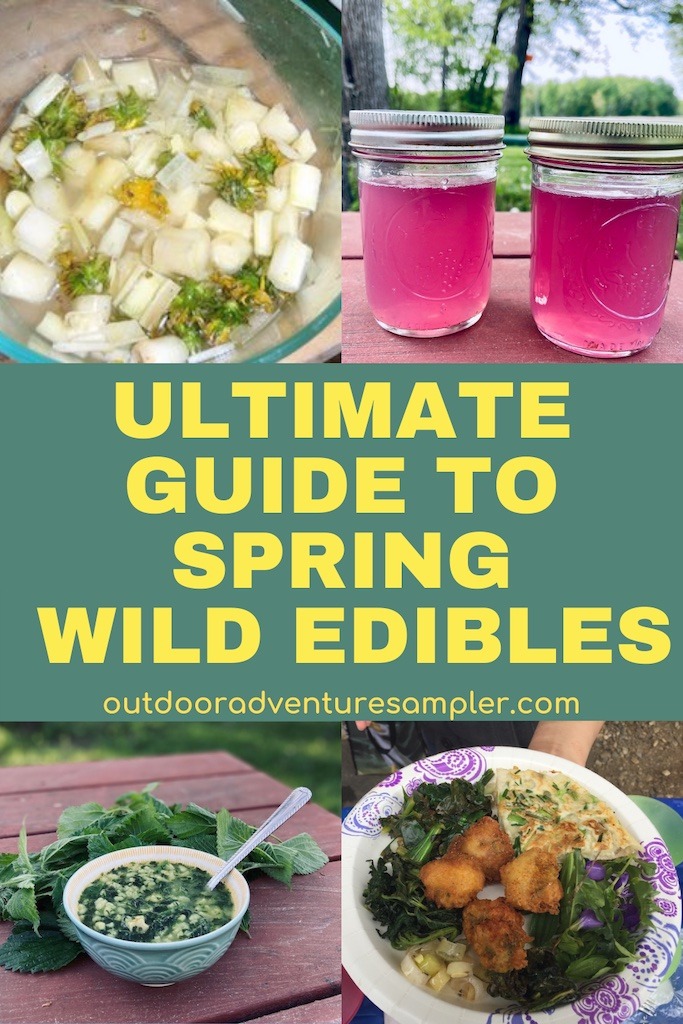

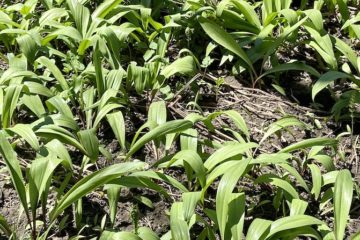
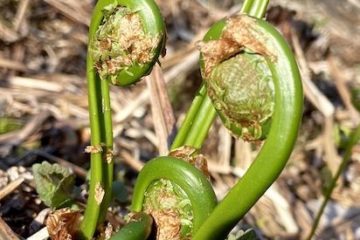
29 Comments
Sue tippett · May 26, 2020 at 5:31 pm
Awesome blog. You are helping us to feed ourselves safely. Thank you.
Karen · June 9, 2020 at 11:06 am
Thanks, Sue. I’m glad you liked the free foods from the wild. More to come.
Susan · May 26, 2020 at 8:17 pm
Once again, you’ve amazed me Karen! These dishes all look so delicious. I can’t tell you how many times I’ve plucked dandelions or played with cattails, not realizing how many ways you can eat them. Thanks for sharing how to enjoy these responsibly 🙂
Karen · June 9, 2020 at 11:04 am
Susan, I hope you get to try some of the wild edible recipes. The outdoor farmer’s market is always open. Many of the ones in the post are available in urban settings too.
Josy · May 27, 2020 at 5:57 pm
That violet jelly looks incredible!
…and you have blown my mind (again) with this Karen! I never even considered eating dandelions, but tempura flowers sounds like a great way to try them! I saw a lade picking a bag of them a couple of weeks ago…now I know why!!
Karen · June 9, 2020 at 11:03 am
Thanks Josy. I find that foraging for wild edibles really adds to an outdoor experience. Hope you try some out.
Lekha C · May 27, 2020 at 7:57 pm
Wow this is incredible! So many cool options. I would love to dig into the jelly and the fritters 🙂
Karen · June 9, 2020 at 11:02 am
The violet jelly is yummy as well as stunningly beautiful.
Julie · May 27, 2020 at 9:36 pm
Wow! I have to say I really learned done this from reading this!! I also might be a little too nervous to try this on my own…might need someone who knows what they are doing to walk me through it!
Karen · June 9, 2020 at 11:01 am
Julie, It’s always great to get a second opinion from someone or confirm in a field guide. The wild edibles in this post are pretty easy to identify.
Farrah · May 27, 2020 at 10:20 pm
I’d heard of nettle tea, but never knew you could actually eat-eat it! That soup sounds awesome! I’ve read about being able to eat cattails before but haven’t had a chance to try it out–it’d be cool to try it in a marinade. :] The violet jelly is gorgeous! The one I’ll probably be able to try the soonest though is probably the dandelion!
Amelia · May 28, 2020 at 11:13 pm
Delightful guide to wild edibles! Every walk in the woods with Karen is deeply valuable and above all so very fun. It’s always pleasant and the lessons learned in this post are experienced in real life with such bounty and jovial lighthearted learning! Thank you for sharing all this treasured information for so many enjoy it near, far and at all times.
Karen · June 9, 2020 at 10:58 am
Wow, a thumbs up from you Amelia always makes my day. Thanks for reading and sharing this love of wild things with me.
Karen · June 9, 2020 at 10:59 am
Farrah, I hope you got a chance to try so of the recipes. I hope to have some summer wild edible ones to share soon.
Hannah · May 28, 2020 at 7:58 am
I have so many of these in my garden! I’m definitely going to try the tempura dandelion heads!
Courtney Byrneheim · May 29, 2020 at 1:48 pm
I agree – the tempura idea is so creative!
Karen · June 9, 2020 at 10:57 am
I hope you like the dandelion tempura. Let me know how it is.
Courtney · May 29, 2020 at 1:46 pm
Wow! You definitely changed my take on stinging nettles! I have never considered them as food before. Also, I have eaten dandelions, but making tempura with the heads is so clever. I should try it! Would be a fun afternoon activity while we’re stuck at home.
Karen · June 9, 2020 at 10:53 am
Courtney, I hope you get to try all the recipes. I started writing this series to give interesting things to do outdoors when we can’t travel far.
Marian · June 9, 2020 at 9:33 am
Hi Karen. Great article. Do you pick your dandelion flowers when the heads are fully open, or when they are closed up tight, for your tempura recipe?
Karen · June 9, 2020 at 10:51 am
Hi Marian. I use fully opened heads. I think the flower petal taste is nice. Enjoy those nettles. The ones you were picking in the video look different from those around here. Special NL nettles?
Amber · June 18, 2020 at 1:17 am
This article is soooo interesting! It reminds me of going foraging with my nan (grandma) and her teaching me all the things you need to know about wild edibles 🙂
Karen · June 18, 2020 at 11:10 am
How lovely to forage with your nan. I learned some of my foraging skills from my mom and am passing them down to my daughters. It’s delightful.
CHELSEA MESSINA · November 29, 2020 at 2:31 pm
i’m obsessed with this article. I’m a gardner, and working towards a more sustainable lifestyle. I had no idea it could be done with these common plants. They are everywhere around where I live – I’m so excited to try and make these dishes in the spring!
Karen · December 2, 2020 at 10:15 am
There is so much to eat in the wild. Foraging is so rewarding. I plan to have more wild edible posts for each season.
Patricia A Scott · June 16, 2022 at 5:48 pm
I read your blog. Wonderful. We may need to find wild plants in order to survive.
People did this during the great depression If we look atthe way the world is going, food shortages, inflation, maybe recession, etc. we may be very glad we read this.
Karen · June 16, 2022 at 8:45 pm
Yes, wild edibles are a wonderful food source. And natural without a lot of chemicals involved. Glad you like the blog.
Jenni / Out in the Nature · May 9, 2023 at 1:26 pm
I didn’t even know that wood nettles exist. We have also two species of nettles but they are stinging nettle (Urtica dioica) and small nettle (Urtica urens) that we call iron nettle. There were some familiar ways of utilizing spring edibles, but the Sishnu soup was something completely new to me. Your blog blows my mind!
Karen · May 9, 2023 at 4:00 pm
Hi Jenni,
With over 40 species of nettles, it’s easy to have different varieties in different parts of the world. I was curious about the Urtica urens nettle so I looked it up. I haven’t seen it before. Where do you find it?